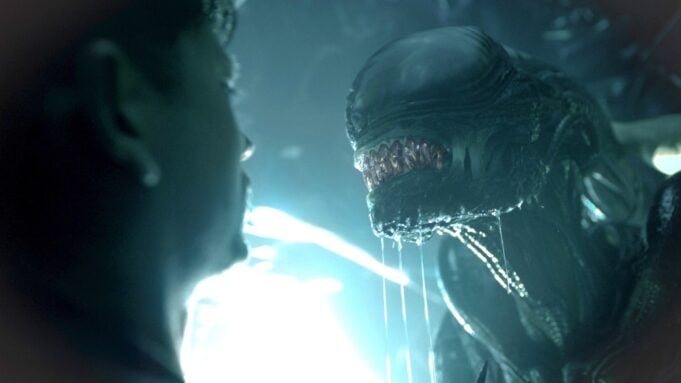There’s now a contradiction built into the very idea of a new “Alien” sequel. “Alien: Romulus” is the seventh entry in the franchise, and each time we line up for another one of them, even when it’s as encrusted with “mythology” as “Prometheus,” the hope is that we’ll get to experience a taste of the shock and awe that “Alien” achieved 45 years ago. “Aliens,” in 1986, conjured enough of that sensation to register as a classic — and though “Alien 3” (1992) is reviled by everyone in the known universe, including its director, David Fincher, I’ve always found, in its maternal-bad-dream-as-art-film way, that it exerts a slow-burn queasy power.
But starting with “Alien: Resurrection” (it’s never a good sign when a film’s title sounds like a pitch to stockholders), the series has been running less on honest dread than on fumes of space-beast nostalgia. The face-hugger, the adult alien with its helmet head and dripping silver jaws, the whole primal terror of your body being not just attacked but invaded — the truth is that the more “Alien” movies you see, the less of a nightmare jolt there is to them.
So when I say that “Alien: Romulus” is one of the best “Alien” sequels, that it delivers the slimy creep-out goods in a way that none of the last three “Alien” films have, I don’t mean to suggest that the shock and awe is back, or that the movie has reinvented this series in any visionary mind-fuck way. Quite the contrary. This is closer to a grandly efficient greatest-hits thrill ride, packaged like a video game. Yet on that level it’s a confidently spooky, ingeniously shot, at times nerve-jangling piece of entertainment.
The film is set during the period between “Alien” and “Aliens,” which is a way of hearkening back while dispensing with the storytelling murk of prequels. Most of it unfolds on the carcass of a sprawling ship, much like the Nostromo, that has been decommissioned and is floating around the cosmos. Rain Carradine (Cailee Spaeny), a mine worker, is lured into joining a group of four young renegades who plan to escape the Jackson Star Mining Colony, which is basically a dystopian corporate prison with no daylight. (Rain, after earning a travel permit, is told that the policy has changed and she must now work another 12,000 hours — i.e., five years — for the right to travel.) If she and her rebel brigade can reach the abandoned ship and restart it, and if there’s enough fuel for nine years of cryo sleep, they can escape.
The ship looks fascinatingly old-fashioned (primitive computer graphics, a cooling system of backlit propeller fans), and it’s not the only thing that does; so do the monsters. The director, Fede Álvarez (“Don’t Breathe,” the “Evil Dead” remake), is a visually brash, dramatically pedestrian showman who stages the alien encounters with a welter of practical effects, which in this retro era tends to get some viewers as excited as a Gen-X hipster cooing over his vinyl collection. Early on, several of the characters explore a passage deck flooded with water, where they encounter things thrashing around them. It’s an army of face-huggers, who are now almost like old friends. (At the screening I attended, rubbery models of them were passed out as PR items, sort of like Leatherface masks.) They don’t seem as powerful as they once did (I don’t remember characters in “Alien” being able to just shake them off), but there is plenty of bony tentacled imagery, and one hugger fastens itself to a crew member, the close-cropped Navarro (Aileen Wu), who soon disgorges a writhing fetus with jaws.
There are other elements there to remind us of “Alien”: a hole burned through layers of the ship, as well as a mangled droid named Rook, played by a digitally reconstituted version of the late Ian Holm (even though his character in “Alien” was named Ash). He looks a bit more svelte than you remember, as if he went on the AI diet — but seriously, if this is what the future of AI re-creation looks like, it’s more creepy than auspicious. Holm’s monologue in “Alien” was one of the film’s highlights, but “Alien: Romulus” isn’t a thriller where the characters pop in the same way. Several of them have off-puttingly indecipherable British accents, and it’s not as if the script fills them in. But “Priscilla’s” Cailee Spaeny, with her clear eyes and serene resolve, makes her presence felt as Rain, the closest equivalent here to the fearless Ripley.
Rain has brought along a droid of her own named Andy, who tells bad jokes and whom she regards as a spiritual brother. He’s played by David Jonsson with a gentle-voiced ambiguity that’s compelling; when he gets reprogrammed into a company stooge, we realize we miss the old Andy more than we do the characters who are being killed off. There’s a disturbing half-formed alien that looks more vaginal than anything we’ve seen in the franchise, as well as an elevator shaft lined with the obsidian exoskeletons of live alien bodies. In a terrific sequence set in an anti-gravity zone, Rain lays waste to this monster army with a mega machine gun, leaving yellow acid blood hanging in blotches in the air.
Love Film & TV?
Get your daily dose of everything happening in music, film and TV in Australia and abroad.
But it’s the final act of “Alien: Romulus” that’s designed to get audience eyes popping: a birth sequence that nods to “Prometheus” and ties the series together, though what’s best about it is simply the flair with which Álvarez stages a lone-woman-vs.-humanoid-alien showdown. It’s a sequence tense enough to grab you by the throat, if not the face.
From Variety US































